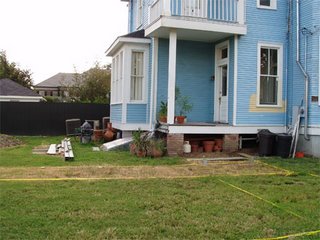Friday, September 01, 2006
A Small Tour of a New Orleans Neighborhood, Part II
 Let's continue through the neighborhood I began describing in Part I of this little travelogue. I'm doing this because the media shows the most graphic scenes of widespread destruction in NOLA; this is good TV. What you don't see as much are the details of destruction and disruption in the "recovered" areas of the city, the parts with the least amount of damage. This is an uptown area near Audubon Park. There's a map of where the photos were taken in Part I.
Let's continue through the neighborhood I began describing in Part I of this little travelogue. I'm doing this because the media shows the most graphic scenes of widespread destruction in NOLA; this is good TV. What you don't see as much are the details of destruction and disruption in the "recovered" areas of the city, the parts with the least amount of damage. This is an uptown area near Audubon Park. There's a map of where the photos were taken in Part I.This first picture shows an innocuous rectangle of dead grass next to a blue house. It was obviously the recent home of a FEMA trailer. The next photo is of a small FEMA trailer park a couple of blocks away with 12-15 trailers. The long building you can barely see behind the trailers is, I believe, part of the Army Corps of Engineers offices up on the levee of the Mississippi. It's been there as long as I can remember and probably since before WWII.
 At least this trailer park is in the city. Many displaced NOLA residents have been put in trailer parks so isolated and far from the city to have been likened to detention camps rather than locations from which to recover lives and homes. Democracy Now! was kicked out of the Renaissance Village Trailer Park when they tried to film and interview residents. "Security" allegedly threatened residents with eviction if they talked to the media while inside the park. "Renaissance Village" (a Bush administration Newspeak name if ever I heard one) is located near Baton Rouge (a few hours from NOLA) and is in an isolated field next to an Exxon oil refinery. About 2,000 people live there, with limited access to transportation or services other than what FEMA provides. Crime and drugs are problems because, surprise! They are miles from the nearest town and lack cars to go elsewhere. Then, to encourage the inhabitants to move out of the trailer park, FEMA begins removing essential services from this "temporary" village. The catch-22s are myriad: No land lines are installed for phones so FEMA gives them cellphones with the first 300 minutes free. Then they have to pay for the minutes. FEMA said they would pay for propane for 18 months then began reneging on that promise after 6 months.
At least this trailer park is in the city. Many displaced NOLA residents have been put in trailer parks so isolated and far from the city to have been likened to detention camps rather than locations from which to recover lives and homes. Democracy Now! was kicked out of the Renaissance Village Trailer Park when they tried to film and interview residents. "Security" allegedly threatened residents with eviction if they talked to the media while inside the park. "Renaissance Village" (a Bush administration Newspeak name if ever I heard one) is located near Baton Rouge (a few hours from NOLA) and is in an isolated field next to an Exxon oil refinery. About 2,000 people live there, with limited access to transportation or services other than what FEMA provides. Crime and drugs are problems because, surprise! They are miles from the nearest town and lack cars to go elsewhere. Then, to encourage the inhabitants to move out of the trailer park, FEMA begins removing essential services from this "temporary" village. The catch-22s are myriad: No land lines are installed for phones so FEMA gives them cellphones with the first 300 minutes free. Then they have to pay for the minutes. FEMA said they would pay for propane for 18 months then began reneging on that promise after 6 months. This building with the pastel green facade seems to have been a local bar. You can see a blue tarp has been attached to the roof. As one writer put it, NOLA became "the city with blue roofs" because of the number of tarps used to temporarily protect them in the aftermath. The detail is hard to make out but the second story wall facing us is quite damaged with boards ripped away. As far as I could tell, this bar didn't show any signs of having re-opened.
This building with the pastel green facade seems to have been a local bar. You can see a blue tarp has been attached to the roof. As one writer put it, NOLA became "the city with blue roofs" because of the number of tarps used to temporarily protect them in the aftermath. The detail is hard to make out but the second story wall facing us is quite damaged with boards ripped away. As far as I could tell, this bar didn't show any signs of having re-opened.I have a few more pictures I might post later but for the moment this is the end of this little tour. Bon chance, NOLA, bon chance.
 The CR FAQ - An Introduction to Celtic Reconstructionist Paganism
The CR FAQ - An Introduction to Celtic Reconstructionist Paganism





